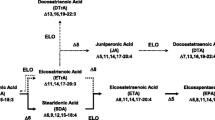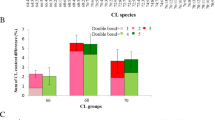Summary
Background
Polyunsaturated fatty acids (PUFAs) modulate immune responses particularly by affecting T cell function and are applied clinically as adjuvant immunosuppressants in the treatment of various inflammatory diseases. However, the molecular mechanisms of PUFA–induced immunosuppressive effects are not yet elucidated. Membrane lipid rafts are functional plasma membrane microdomains characterized by a unique lipid environment. Since lipid interactions are crucial for the formation of lipid rafts, the immunomodulatory effects of PUFAs may be due to changes of fatty acid composition in lipid rafts.
Aim of the study
We investigated the effects of eicosapentaenoic acid (EPA, 20:5 n – 3) supplementation on modulating lipid composition and fatty acyl substitution in their cytoplasmic and exoplasmic lipid leaflet in lipid rafts.
Methods
The human Jurkat E6–1 T cells were cultured in EPA–supplemented medium and the cells treated with stearic acid served as a control. Lipid rafts were isolated by discontinuous sucrose density gradient ultracentrifugation. The lipids in raft and soluble fractions from EPA–treated and control T cells were extracted and separated by gas chromatography. Raft phospholipids were analyzed by mass spectrometry.
Results
Our results showed that EPA treatment could alter lipid composition resulting in a considerable increase of unsaturated fatty acyl chains in lipid rafts from EPA–treated T cells compared with control cells. Effective incorporation of EPA to rafts was not only in the exoplasmic but also in the cytoplasmic membrane lipid leaflet. EPA treatment altered the lipid environment in lipid rafts. EPA presented an inhibiting effect on Jurkat T cells proliferation and inhibited IL–2Rα expression on the surface of T cells.
Conclusions
Our data provided evidence for an important modification in lipid composition of membrane lipid rafts and T cell function by EPA supplementation.
Similar content being viewed by others
Abbreviations
- PUFAs:
-
polyunsaturated fatty acids
- EPA:
-
eicosapentaenoic acid
- PC:
-
phosphatidylcholine
- PE:
-
phosphatidylethanolamine
- PS:
-
phosphatidylserine
- PI:
-
phosphatidylinositol
- SM:
-
sphingomyelin
References
Belluzzi A, Brignola C, Campieri M, Pera A, Boschi S, Miglioli M (1996) Effect of an enteric-coated fish-oil preparation on relapses in Crohn’s disease. N Engl J Med 334:1557–1560
Cappelli P, DiLiberato L, Stuard S, Ballone E, Albertazzi A (1997) n-3 polyunsaturated fatty acid supplementation in chronic progressive renal disease. J Nephrol 10:157–162
Webb Y, Hermida-Matsumoto L, Resh MD (2000) Inhibition of protein palmitoylation, raft localization, and T cell signaling by 2-bromopalmitate and polyunsaturated fatty acids. J Biol Chem 275:261–270
Switzer KC, Fan YY, Wang N, McMurray DN, Chapkin RS (2004) Dietary n-3 polyunsaturated fatty acids promote activation-induced cell death in Th1-polarized murine CD4+ T-cells. J Lipid Res 45:1482–1492
Calder PC, Yaqoob P, Thies F, Wallace FA, Miles EA (2002) Fatty acids and lymphocyte function. Br J Nutr 87 (Suppl):31–48
Brouard C, Pascaud M (1990) Effects of moderate dietary supplementations with n-3 fatty acids on macrophage and lymphocyte phospholipids and macrophage eicosanoid synthesis in the rat. Biochim Biophys Acta 1047:19–28
Rossetti RG, Seiler CM, DeLuca P, Laposata M, Zurier RB (1997) Oral administration of unsaturated fatty acids: effects on human peripheral blood T lymphocyte proliferation. J Leuk Biol 62:438–443
Stulnig TM, Huber J, Leitinger N, Imre EM, Angelisová P, Nowotny P, Waldhäusl W (2001) Polyunsaturated eicosapentaenoic acid displaces proteins from membrane rafts by altering raft lipid composition. J Biol Chem 276:37335–37340
Fan YY, McMurray DN, Ly LH, Chapkin RS (2003) Dietary (n-3) polyunsaturated fatty acids remodel mouse T-cell lipid rafts. J Nutr 133:1913–1920
Wu C, Butz S, Ying Y, Anderson RGW (1997) Tyrosine kinase receptors concentrated in caveolae-like domains from neuronal plasma membrane. J Biol Chem 272:3554–3559
Dillon SR, Mancini M, Rosen A, Schlissel MS (2000) Annexin V binds to viable B cells and colocalizes with a marker of lipid rafts upon B cell receptor activation. J Immunol 164:1322–1332
Holowka D, Sheets ED, Baird B (2000) Interactions between FcåRI and lipid raft components are regulated by the actin cytoskeleton. J Cell Sci 113:1009–1019
Janes PW, Ley SC, Magee AL, Kabouridis PS (2000) The role of lipid rafts in T cell antigen receptor (TCR) signaling. Sem Immunol 12:23–34
Stulnig TM, Berger M, Sigmund T, Raederstorff D, Stockinger H, Waldhäusl W (1998) Polyunsaturated fatty acids inhibit T cell signal transduction by modification of detergent-insoluble membrane domains. J Cell Biol 43:637–644
Zeyda M, Staffler G, Ho ej V, Waldhäusl W, Stulnig TM (2002) LAT displacement from lipid rafts as a molecular mechanism for the inhibition of T cell signaling by polyunsaturated fatty acids. J Biol Chem 277:28418–28423
Author information
Authors and Affiliations
Corresponding author
Rights and permissions
About this article
Cite this article
Li, Q., Tan, L., Wang, C. et al. Polyunsaturated eicosapentaenoic acid changes lipid composition in lipid rafts. Eur J Nutr 45, 144–151 (2006). https://doi.org/10.1007/s00394-005-0574-7
Received:
Accepted:
Published:
Issue Date:
DOI: https://doi.org/10.1007/s00394-005-0574-7




